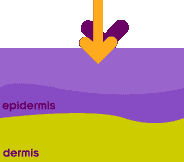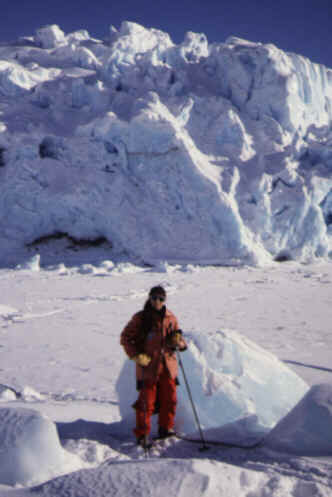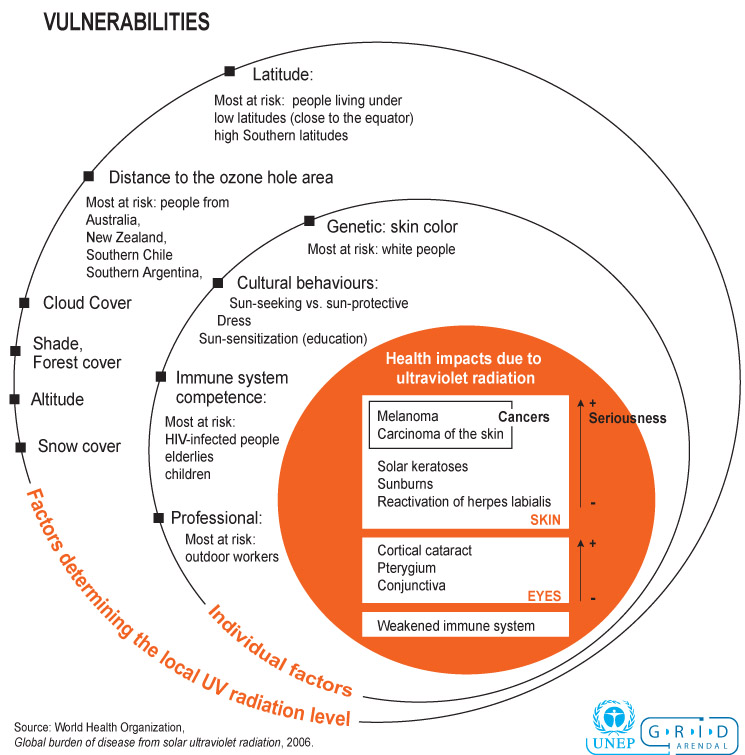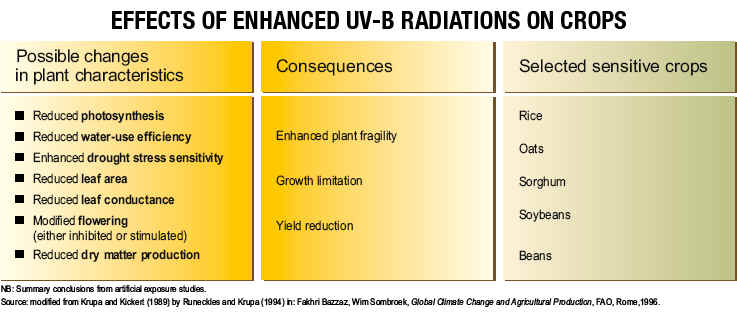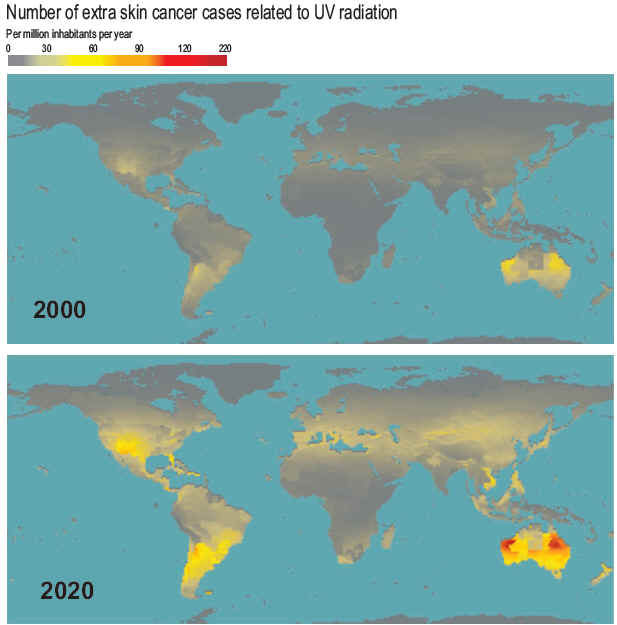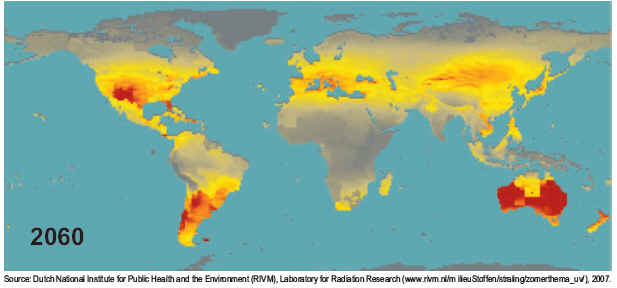|
Ozone Hole Consequences The Southern Ocean is one of the world's most productive marine ecosystems, home to huge numbers of penguins, seals, and bottom plants, and a major supplier of nutrients carried to other parts of the world by undersea currents. Little is known about the effect of UV-B on marine life, particularly the microscopic algae called phytoplankton that form the foundation of the undersea food chain. These tiny plants capture the sun's energy through photosynthesis, providing food for microscopic animals.
phytoplankton images They are eaten by krill, which sustain the Antarctic's abundant seals, penguins, and baleen whales.
Antarctic Krill Photo Courtesy of Less phytoplankton means less food for these animals to eat. It is estimated that a 16 % ozone depletion could result in further losses in Phytoplankton, which would lead to a loss of about 7 million tons of fish per year. With the human food supply already strained due to demands of an ever-increasing population, small reductions resulting from UV damage may be disastrous to many people, especially the poor and indigenous people.
UV Rays enter the human body Researchers say it's clear that UV-B harms Antarctic microbes. Dr Patrick Neale, of the Smithsonian Environmental Research Center, has predicted that phytoplankton photosynthesis declines by as much as 8.5 per cent under the worst conditions.
DNA It also damages the DNA of marine bacteria and the larvae of starfish and urchins, they say. And it even alters ocean chemistry, creating potentially dangerous substances in the water itself. "This refers to the fact that UV radiation is involved in a number of photochemical reactions in seawater (including the hydrolysis/splitting of water molecules) that produce radicals (hydroxyl, peroxide, superoxide, etc.). These radicals are very reactive and can cause biological damage by oxidizing biological molecules. It's really dramatic what the changes in ozone levels will do to rates of DNA damage and inhibited development," says biologist Deneb Karentz of the University of San Francisco. "If you have a 30 per cent decline in ozone, that doesn't mean a 30 per cent decline in a given biological process - it could be a lot more than that". Experts predict that an estimated 10 % reduction in the ozone layer will result in a 25 % increase in non-melanoma skin cancer rates for temperate latitudes by the year 2050.
Deneb Karentz of the University of San Francisco Professor of Environmental Science and Biology Chair, Department of Biology Photograph taken near Palmer Station, a US research base on Anvers Island along the Antarctic Peninsula
The burning goes deeper however, than sunburn, skin cancers, and cataracts. Wearing certain sunglasses may enhance exposure of the lens and retina to harmful UV rays, because the iris opens wider to compensate for the reduced visible light and then more penetration of UV can reach the retina. Through other similar mechanisms, UV rays can suppress the human immune system leaving the body vulnerable to many diseases caused by bacteria and viruses entering through or affecting the skin. While darker skinned individuals are less likely to contract a skin cancer from sun exposure, dark skin is not a protection against immune suppression by UV. But dark skin does require a greater dosage of UV than white skin to initiate immune suppression. Increased exposure to UV rays in animals and humans has been linked to elevated risk from the following diseases: the herpes viruses, the human immunodeficiency virus HIV- 1, a variety of papilloma viruses, leishmaniasis, malaria, forms of tuberculosis, leprosy, lupus erthematodes, dermatitis, E. coli, and Staphylococcus aureus. Since UV rays readily damage DNA in all cells, it is not unrealistic to hypothesize that this will play an additional role in the mutation of existing disease bacteria and viruses and may produce totally new strains of pathogens. Physicians are finding that infection and disease is a greater global challenge than cancer, as people of all skin pigmentation are at equal risk from the effects of immuno-suppression. Geographic areas of poor public health are at even greater risk.
Australian Skin Cancer
Australians
suffer the highest rates of skin cancer in the world. Each year, around 1,200
Australians die from what is an almost totally preventable disease. Everyone can
develop skin cancer; however, some people may be at higher risk than others, due
to a range of factors.
First launched by a cartoon seagull singing ‘Slip! Slop! Slap!’ on TV screens in 1980,
SunSmart adopted its name and mission in 1988. An initiative of The Cancer Council Victoria and supported by the Victorian Health Promotion Foundation, SunSmart was developed to combat spiralling skin cancer incidence and mortality rates. Since then, attitudes towards tanning and sun protection have changed dramatically. Australians have realised the pitfalls of their sun-loving, outdoor lifestyle and are taking preventative measures to reduce their risk of sun damage and skin cancer. Research by The Cancer Council Victoria shows SunSmart’s messages have reached a majority of Australians and had a stong impact on their behaviour. Consequently, skin cancer deaths have slowed and for females, have even started to decline. More Australians are detecting skin cancers early, increasing their chances of surviving the disease.
http://www.sunsmart.com.au/index.htm
2007 United States Skin Cancer Facts & Figures
Credit: American Cancer Society's 2007 Facts & Figures
Health Effects of Overexposure to the Sun |
|
Since the appearance of an ozone hole over the Antarctic in the early 1980s, Americans have become aware of the health threats posed by ozone depletion, which decreases our atmosphere's natural protection from the sun's harmful ultraviolet (UV) rays. This fact sheet provides a quick overview of the major health problems linked to overexposure to UV radiation: Skin CancerThe incidence of skin cancer in the United States has reached epidemic proportions. One in five Americans will develop skin cancer in their lifetime, and one American dies every hour from this devastating disease. Medical research is helping us understand the causes and effects of skin cancer. Many health and education groups are working to reduce the incidence of this disease, of which 1.3 million cases have been predicted for 2000 alone, according to The American Cancer Society.
Other Skin DamageOther UV-related skin disorders include actinic keratoses and premature aging of the skin. Actinic keratoses are skin growths that occur on body areas exposed to the sun. The face, hands, forearms, and the "V" of the neck are especially susceptible to this type of lesion. Although premalignant, actinic keratoses are a risk factor for squamous cell carcinoma. Look for raised, reddish, rough-textured growths and seek prompt medical attention if you discover them. Chronic exposure to the sun also causes premature aging, which over time can make the skin become thick, wrinkled, and leathery. Since it occurs gradually, often manifesting itself many years after the majority of a person's sun exposure, premature aging is often regarded as an unavoidable, normal part of growing older. With proper protection from UV radiation, however, most premature aging of the skin can be avoided. Eye DamageUV exposure can cause health concerns other than cancer. Cumulative damage from repeated UV exposure may contribute to chronic eye disease. UV rays can harm the cornea--the transparent front part of the eye. Because long-term sunlight is thought to cause cataracts or clouding of the lens of the eye, UV-protective sunglasses are recommended. source: United States Environmental Protection Agency
The SunWise Program is an environmental and health education program that aims to teach the public how to protect themselves from overexposure to the sun through the use of classroom-based, school-based, and community-based components.
|
||||||




